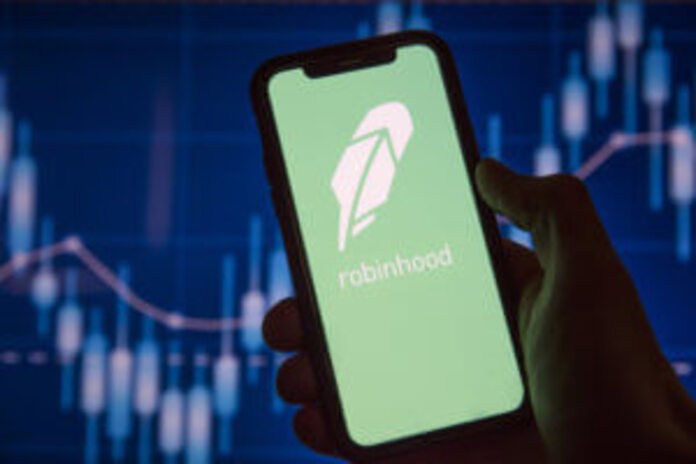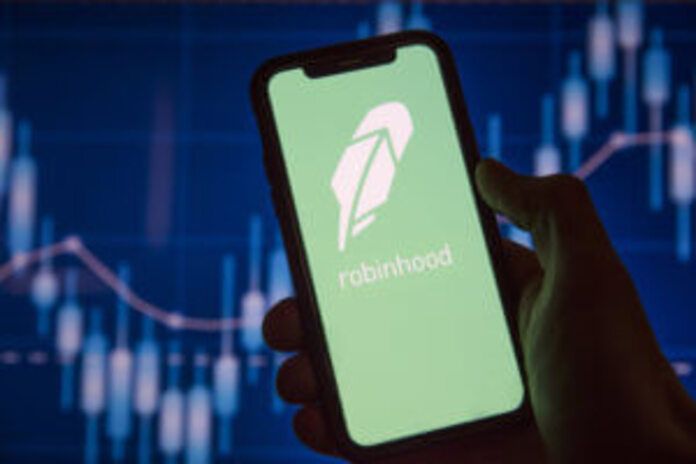Robinhood Crypto Trading Gains Momentum

Robinhood (NASDAQ:HOOD) has made significant strides in the cryptocurrency trading market, capitalizing on its commission-free model to attract price-conscious traders. This strategic expansion is putting pressure on major digital asset exchanges like Coinbase (NASDAQ:COIN) and Binance, marking a shift in the competitive landscape of crypto investing.
Record Crypto Revenue Boosts Robinhood Stock
Robinhood’s latest earnings report showcased an astounding eight-fold increase in transaction-based revenue from crypto trading for the fourth quarter of 2024. As a result, its stock surged nearly 14% in early trading, adding approximately $6 billion to its market capitalization. Analysts attribute this growth to increasing retail investor interest and a favorable regulatory outlook.
President Donald Trump’s pro-crypto stance has also played a role in fueling market enthusiasm. His pledge to position the U.S. as the “crypto capital of the planet” sent Bitcoin (BTC) soaring past $100,000 in Q4 2024, reinforcing bullish sentiment across digital asset markets.
Robinhood Challenges Coinbase and Binance
While Robinhood crypto trading has gained traction, analysts believe competing with established crypto exchanges will not be easy. Platforms like Coinbase and Binance cater to more crypto-savvy users, offering a broader selection of tokens and advanced trading tools. Currently, Robinhood lists only about 22 cryptocurrencies, whereas Coinbase supports over 200.
Despite these challenges, Robinhood’s influence in the trading industry cannot be ignored. The platform disrupted traditional brokerage firms like Charles Schwab (NYSE:SCHW) and Fidelity by introducing commission-free stock trading in 2013. Now, it is leveraging that same disruptive approach to expand its foothold in crypto.
Analysts Remain Bullish on Robinhood Stock
Industry experts foresee continued momentum for Robinhood crypto trading. Analysts at Bernstein recently named Robinhood their “best idea for 2025,” citing expectations of sustained growth in crypto trading volumes.
Paul Marino, Chief Revenue Officer at Themes ETFs, highlighted that rising equity, options, and crypto trading volumes signal renewed confidence among retail traders. He also noted that younger investors are embracing Robinhood’s platform, further driving its growth.
Future Outlook: Can Robinhood Sustain Its Crypto Momentum?
Although Robinhood has experienced significant success, maintaining its competitive edge in the crypto market requires further innovation. The company may need to expand its cryptocurrency offerings, introduce staking and lending services, and enhance security measures to attract more advanced traders.
Meanwhile, Coinbase is set to release its earnings report, which will provide further insight into how the competition between these two trading giants unfolds. As Robinhood continues to grow its crypto segment, its impact on the broader digital asset industry remains a focal point for investors.
With Robinhood crypto trading becoming an increasingly vital component of the company’s business model, the race for dominance in the retail trading space is far from over.
Robinhood’s ability to attract new users and retain existing ones will be crucial to sustaining its crypto market momentum. Expanding educational resources on digital assets and offering lower spreads on transactions could further enhance its competitive position. Additionally, forming strategic partnerships with blockchain projects or integrating decentralized finance (DeFi) features may help Robinhood differentiate itself from traditional exchanges.
Regulatory clarity will also play a pivotal role in determining Robinhood’s future in crypto. If the U.S. Securities and Exchange Commission (SEC) adopts a more favorable stance toward crypto trading platforms, Robinhood could benefit significantly. However, increased scrutiny and potential restrictions on certain digital assets could pose challenges.
As retail and institutional interest in cryptocurrencies continues to grow, Robinhood’s commitment to innovation and user experience will dictate its success. Investors will be watching closely to see if Robinhood can maintain its growth trajectory and solidify its presence in the rapidly evolving digital asset market.
Featured Image: Megapixl







